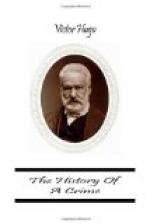The Commissary of the Arsenal Police had that morning received from the Prefect Maupas the order to search everywhere for the place where the High Court of Justice might be sitting, if perchance it thought it its duty to meet. Confusing the High Court with the Council of State, the Commissary of Police had first gone to the Quai d’Orsay. Having found nothing, not even the Council of State, he had come away empty-handed, at all events had turned his steps towards the Palace of Justice, thinking that as he had to search for justice he would perhaps find it there.
Not finding it, he went away.
The High Court, however, had nevertheless met together.
Where, and how? We shall see.
At the period whose annals we are now chronicling, before the present reconstruction of the old buildings of Paris, when the Palace of Justice was reached by the Cour de Harlay, a staircase the reverse of majestic led thither by turning out into a long corridor called the Gallerie Merciere. Towards the middle of this corridor there were two doors; one on the right, which led to the Court of Appeal, the other on the left, which led to the Court of Cassation. The folding-doors to the left opened upon an old gallery called St. Louis, recently restored, and which serves at the present time for a Salle des Pas Perdus to the barristers of the Court of Cassation. A wooden statue of St. Louis stood opposite the entrance door. An entrance contrived in a niche to the right of this statue led into a winding lobby ending in a sort of blind passage, which apparently was closed by two double doors. On the door to the right might be read “First President’s Room;” on the door to the left, “Council Chamber.” Between these two doors, for the convenience of the barristers going from the Hall to the Civil Chamber, which formerly was the Great Chamber of Parliament, had been formed a narrow and dark passage, in which, as one of them remarked, “every crime could be committed with impunity.”
Leaving on one side the First President’s Room and opening the door which bore the inscription “Council Chamber,” a large room was crossed, furnished with a huge horse-shoe table, surrounded by green chairs. At the end of this room, which in 1793 had served as a deliberating hall for the juries of the Revolutionary Tribunal, there was a door placed in the wainscoting, which led into a little lobby where were two doors, on the right the door of the room appertaining to the President of the Criminal Chamber, on the left the door of the Refreshment Room. “Sentenced to death!—Now let us go and dine!” These two ideas, Death and Dinner, have jostled against each other for centuries. A third door closed the extremity of this lobby. This door was, so to speak, the last of the Palace of Justice, the farthest off, the least known, the most hidden; it opened into what was called the Library of the Court of Cassation, a large square room lighted by two windows overlooking the great inner yard of the Conciergerie, furnished with a few leather chairs, a large table covered with green cloth, and with law books lining the walls from the floor to the ceiling.




